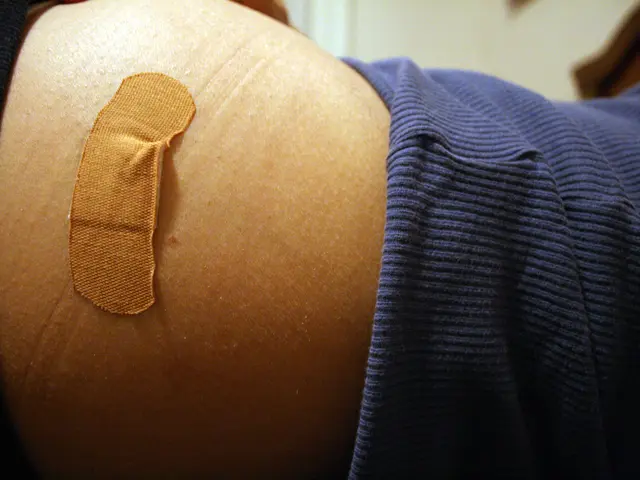Baby Oral Thrush: Causes, Signs, and Remedies
Oral thrush, a common mouth infection in infants, is caused by the yeast-like fungus Candida albicans. This infection can be a source of concern for parents and caregivers, but understanding its causes, symptoms, and treatment can help alleviate worries.
The primary cause of oral thrush in infants and children involves the overgrowth of the fungus *Candida*. This overgrowth occurs due to certain risk factors or conditions, such as antibiotic use, inhaled corticosteroid use, poor hygiene of feeding implements, immune status, and perinatal exposure to *Candida*.
Antibiotic treatment contributes to the development of oral thrush by disrupting the balance of normal oral bacteria, allowing *Candida* to overgrow and cause infection. Similarly, inhaled corticosteroids, often prescribed for asthma, can promote thrush by suppressing local immune defenses in the mouth. Frequent use of pacifiers or bottles, especially if not cleaned properly, can also encourage yeast growth in the warm, moist environment they create.
Infants born with low birth weight, those with weakened immune systems, or those exposed to *Candida* during birth from a mother with a yeast infection are at higher risk. Transmission between mother and infant during breastfeeding is also notable; thrush can pass back and forth even if one appears asymptomatic.
The typical symptoms of oral thrush include creamy white or yellow patches on the tongue, inner cheeks, gums, or throat, which can be painful and make feeding difficult in some infants. Other symptoms may include red tissue that bleeds easily under the white lesions, redness around the patches, painful patches, cracked corners of the mouth, and patches of white that cannot be wiped away.
If a woman develops a vaginal yeast infection during pregnancy, she should consult a doctor, as it may be passed to the newborn during delivery. If an infant is breastfeeding, the mother's nipples may need to be treated to prevent the infection from passing back and forth. It is important to note that oral thrush can happen after treatment with antibiotics, as antibiotics reduce the levels of healthy bacteria in the mouth, allowing fungus to proliferate.
Treatment usually involves antifungal medicines to restore the natural balance and resolve the infection. A doctor may advise parents or caregivers to monitor oral thrush in infants without using medication, as it often resolves within 2 weeks. However, if symptoms of oral thrush persist, it is crucial to notify the pediatrician, as it may affect feedings.
While there are suggestions for natural remedies for oral thrush in infants, such as lactobacilli found in yogurt or supplements containing lactobacilli suitable for infants, their safety and effectiveness are not proven. It is always advisable to discuss any type of remedy with a doctor before giving it to an infant.
In conclusion, oral thrush in infants is a common condition that can be caused by various factors. By understanding its causes, symptoms, and treatment, parents and caregivers can take the necessary steps to prevent and treat oral thrush effectively. If you suspect your infant has oral thrush, consult your healthcare provider for a proper diagnosis and treatment plan.
[1] Mayo Clinic. (2021). Oral thrush. https://www.mayoclinic.org/diseases-conditions/oral-thrush/symptoms-causes/syc-20355434 [2] American Academy of Pediatrics. (2018). Oral thrush. https://www.healthychildren.org/English/health-issues/conditions/infections/Pages/Oral-Thrush.aspx [3] MedlinePlus. (2021). Oral thrush. https://medlineplus.gov/ency/article/000986.htm
- Oral thrush, a common fungal infection of the mouth in infants, can be attributed to an overgrowth of the fungus Candida.
- The overgrowth of Candida can be triggered by various risk factors, such as antibiotic use, inhaled corticosteroids, improper cleaning of feeding implements, immune status, and perinatal exposure to Candida.
- Antibiotics contribute to oral thrush by reducing the levels of healthy bacteria in the mouth, creating an environment for Candida to thrive.
- Inhaled corticosteroids, often prescribed for asthma, can weaken local immune defenses in the mouth, promoting the growth of Candida.
- Infants with low birth weight, weakened immune systems, or perinatal exposure to Candida carry a higher risk of oral thrush.
- A mother with a vaginal yeast infection during pregnancy can transmit Candida to her newborn during delivery.
- Symptoms of oral thrush in infants include creamy white or yellow patches on the tongue, inner cheeks, gums, or throat, which may be painful and interfere with feeding.
- Severe symptoms may include red tissue that bleeds easily under the white lesions, redness around the patches, painful patches, cracked corners of the mouth, and patches of white that cannot be wiped away.
- Women experiencing vaginal yeast infections during pregnancy should consult a doctor to prevent transmission to the newborn during delivery.
- Mothers breastfeeding infants with oral thrush may need treatment to prevent the infection from passing back and forth.
- If oral thrush persists for more than two weeks in infants, it is crucial to seek medical attention from a pediatrician.
- Natural remedies such as lactobacilli found in yogurt or supplements may be suggested for oral thrush in infants, but their safety and effectiveness are not proven.
- Consulting a doctor before attempting any natural remedies is advisable to ensure their safety and effectiveness for infants.
- By understanding the causes, symptoms, and treatment of oral thrush, parents and caregivers can take effective steps to prevent and treat oral thrush in infants.
- Resources, such as the Mayo Clinic, the American Academy of Pediatrics, and MedlinePlus, offer valuable information about oral thrush.
- Chronic diseases, such as cancer, respiratory conditions, digestive health issues, eye health problems, hearing issues, and neurological disorders, may require specific attention and therapies when dealing with oral thrush.
- The importance of eating a balanced diet, maintaining fitness and exercise, practicing good skin care, managing weight, and addressing mental health, mens health, sexual health, skin conditions, autoimmune disorders, and aging—all aspects of health and wellness—should be considered to promote overall well-being and combat oral thrush.




